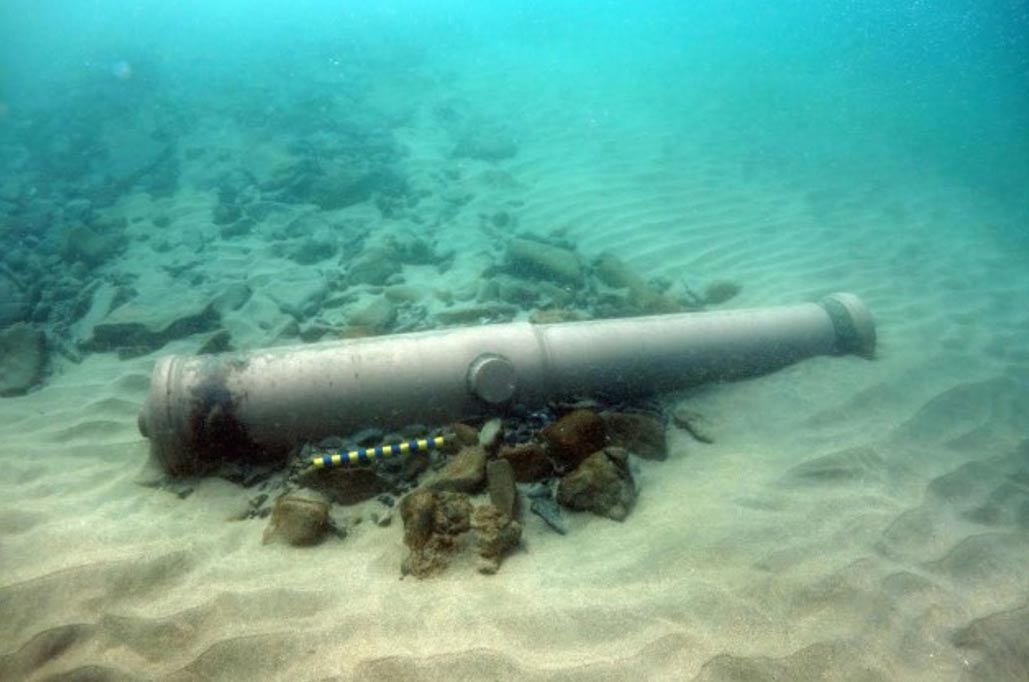Bad weather reveals stunning relics from the Spanish Armada
In 2015 archaeologists made a fascinating discovery when cannons from the La Juliana, a merchant vessel commandeered by King Phillip II of Spain into the Spanish Armada, were washed into shallow waters off Ireland, due to prolonged winter storms.
The discoveries, which have been described as ‘highly significant’, began in April of that year, when wooden beams from the ship started washing ashore near Streedagh in County Sligo.
La Juliana was a merchant vessel that was sailing as part of the Spanish Armada when it sank off the coast of Ireland, along with two other vessels sailing nearby, due to bad weather in 1588. Around 24 ships in total may have been sunk off Ireland after the Armada had been broken up and dispersed by English ships under the command of Sir Francis Drake and Charles Howard. The ship was built as a Spanish merchant vessel, but when King Phillip II of Spain decided to attempt an invasion of England it was commandeered, along with many other vessels, as part of the ‘Spanish Armada’. Its two companions, the La Lavia and the Santa Maria de Vision, may be lying close by, protected by the sand on the seabed. When the three ships sank, over 1,000 sailors and soldiers lost their lives.

Typical ship of the Spanish Armada (Wikimedia Commons)
Phillip II and Queen Elizabeth I actually met on one occasion in May 1555. Neither monarch sought conflict, but England and Spain drifted into war anyway, probably because of the Empresa de Inglaterra (the Enterprise of England) as it was known in the Catholic world of the time, the declared attempt to overthrow the new Protestant regime in England. Plans to invade England began to be drawn up in summer 1559, when it was suggested to Phillip that his journey down the English Channel could also be used as a springboard for an armed landing on the English coast. However, Phillip rejected this idea, a sign of his constant caution not to provoke Elizabeth, particularly as she was careful to treat English Catholics moderately well. Phillip also advised the Pope not to rush into anything.
This attitude changed with the rebellion in The Netherlands towards the end of the 1560s, which some said had been provoked by England. Yet, Phillip recognised the dangers of attempting an invasion from Spain which would have needed a sizeable maritime operation. The Spanish king also recognised the effectiveness of the English navy. Phillip finally decided to attempt an invasion after recovering from illness in autumn 1585 and preparations for the operation began in 1586. It took over two years before the Armada was ready. The delay may have been exacerbated by a raid on Cadiz by Sir Francis Drake in 1587. The preparations were further delayed in 1588 meaning that the Armada didn’t arrive off the coast of Lands’ End until July 1588.
- In Search of the San Marcos of the Spanish Armada
- Thames Shipwreck identified as Cherabin, English pirate ship that pillaged for the Queen

King Phillip amassed a sizeable fleet, which came to be known as the Spanish Armada (Wikimedia Commons)
The English fleet was caught unawares, since it had been re-supplying in Plymouth harbour. The 66 ships managed to escape from Plymouth and withdraw up the English Channel, fighting the Spanish as they did so, including an engagement with them off the coast of Portland. The commander of the Armada, the duke of Medina Sidonia, then decided to rest the Armada at Calaise. This in turn gave the English the chance to disperse it with eight fire ships which were sent against the Armada at midnight on 28 th July. Following another engagement, the Battle of Gravelines, the Armada was blown into the North Sea by strong winds, which meant it had no option other than to sail round the coast of England and down into the Irish Sea, where at least 35 ships were lost.

Defeat of the Spanish Armada, 8 August 1588 by Philip James de Loutherbourg (Wikimedia Commons)
La Juliana weighed 860 tons and carried a crew of 70. It was armed with 32 cannons. Two of them, made of bronze, have now been found on the seabed.
The two guns are in almost pristine condition and one of them is decorated with an image of St Matrona, who was venerated by the people of Catalonia and Barcelona. This cannon is also dated 1570, which is the year the La Juliana was built, in effect confirming the ship’s identity. The material discovered is of enormous archaeological and historical significance.

Cannon decorated with an image of St Matrona. Source: Screenshot from RTE video
“We have uncovered a wealth of fascinating and highly significant material, which is more than 425 years old” Heather Humphries, Irish Minister for Arts, Heritage and the Gaeltacht, told ITV. “This material is obviously very historically and archaeologically significant.”
Along with the cannons and the wooden timbers, an anchor from the ship has also been discovered. It will take a number of weeks to recover the remaining guns and so a security operation is now in place to protect the wreck from treasure hunters.
In the summer of 2017 researchers set out to see if a sonar survey could help them recover more artifacts from the wreckage. The sonar survey was also expected to help them add to the currently low number of Spanish Armada wrecks that have been found to date. Fionnbarr Moore, senior archaeologist on the Underwater Archaeology Unit of the National Monuments Service, told thejournal.ie:
“There are others we know roughly where they went down. We have a rough idea but there’s an attempt to find the San Marcos at the moment – it went down off Co Clare. They haven’t succeeded in locating it yet. We’re going to check out more anomalies, assessing what might be there and what could be done.”
Featured image: Spanish Armada cannon found off the coast of Ireland. Source: Department of Arts, Heritage and the Gaeltacht

















